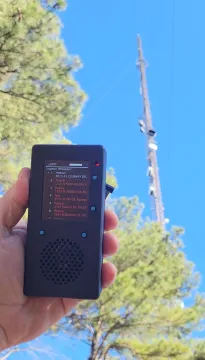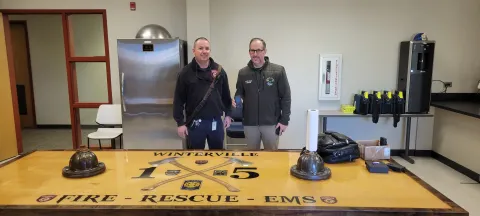
Imagine the unthinkable: a natural disaster strikes, vehicles collide on a snowy highway, a 5-alarm fire blazes through the night. In these moments, we rely on our first responders to arrive on the scene and render lifesaving care swiftly and efficiently. Every second counts, and open communication is essential to mission success. This is why the DHS Science and Technology Directorate (S&T) is collaborating on a new effort to arm agencies with a digital alerting system that taps into NEXTGEN public TV broadcasting technologies to deliver emergency dispatches faster.
An estimated 240 million calls are made to 911 in the U.S. each year. “Agencies need to have the most up-to-date technologies and tools that will enable them to continue answering and responding to these calls in a timely fashion,” said S&T program manager Karen “Maua” Johnson. “We are collaborating with several partners to ensure that they have access to these resources, and also enhance technology for a more reliable and seamless communication capability.”
Thanks to a Small Business Innovation Research program award, S&T has joined forces with wireless technology engineering firm Device Solutions Inc., the Wireless Research Center of North Carolina, PBS North Carolina, Triveni Digital, and additional government and private stakeholders to prototype an extensible, end-to-end emergency digital paging solution that utilizes public television broadcasting technology (ATSC 3.0) to transmit emergency data to first responders across the state of North Carolina. ATSC 3.0 was chosen for its ability to support emergency response agencies as they increasingly turn to the use of multimedia such as video and photo messaging, file transfers, and location sharing as their primary means of receiving critical information during emergencies.

For this initiative, S&T and Device Solutions Inc developed and deployed a custom, portable, ATSC 3.0 receiver with first responders to demonstrate and verify that it could deliver critical emergency data and improve situational awareness. Once implemented in the field, this technology will serve as a flexible tool that can be readily adapted to a variety of datacasting applications and types of media.
“ATSC 3.0 datacasting can prove to be an effective secondary means of secure communication to increase situational awareness and supplement or replace the older analog radio and cellular technologies that are currently being used by our first responders,” said Device Solutions Director of Technology Strategy Tony Sammarco.

Most existing infrastructure for radios and cellular devices are unique to each state, county, or jurisdiction and don’t have the bandwidth to support newer forms of multimedia communications that are more commonly being used in the field. They are also usually not standardized or designed to be interoperable with their neighbors. “These all serve as major challenges for EMS, as interagency and cross-state or county collaboration is increasingly necessary to ensure success during emergency situations,” added Sammarco.
S&T’s goal: Support the commercialization of a nationwide standardized and interoperable digital emergency paging system over ATSC 3.0 public broadcasting. The system will enable agencies to immediately and effectively transmit and receive all types of emergency call data, regardless of where they are in the field.
“Developing this paging system and associated technologies poses a very unique challenge,” explained Johnson. “We asked ourselves, ‘how do we create a communications network and infrastructure that meets all the needs of our first responders?’ And ‘how do we develop and implement a suite of technologies that will be compatible with this system?’”
The answers seemed to lie in an existing and accessible resource – public TV broadcasting technologies and data networks.
A state-of-the-art normalization server and a dedicated ATSC 3.0 emergency data channel, along with complementary paging receivers and smartphone apps, will all work in tandem. Together, they will prepare emergency call data and transmit it to responders in the field through public TV broadcasting tech and data networks.
“Our server is designed to compile data from emergency call centers all over the country and convert it, or ‘normalize’ it into a standardized uniform format that can be relayed to our private emergency data channel,” said Sammarco. “This secure channel, which will not interfere with simultaneous NEXTGEN TV broadcasts, will transmit critical data via public TV to our paging receivers, which then alert the appropriate responders through our paging receivers and smartphone applications.”
S&T and Device Solutions recently conducted two weeks of live field- and end-user testing in selected regions and jurisdictions across the coastal, central, and mountainous regions of North Carolina.
“First responders often work in all sorts of terrains and settings,” said Johnson. “We needed to be sure that our tools can provide sufficient coverage and enable them to receive data in the field, regardless of where they are.”
The team worked closely with Public Broadcasting Service North Carolina and Raleigh-based Capital Broadcasting Company station WNGT to ensure ATSC 3.0 broadcast coverage, and with several local EMS jurisdictions to establish connections with emergency dispatch centers so that relevant emergency call data could then be normalized and routed via Device Solutions’ normalization server to a Triveni Digital transport encoder for transmission over local public TV broadcast towers. Participating fire departments in the selected testing areas were then issued prototype paging receivers and a smartphone app so they could assess how well these technologies performed in real-time.
Overall feedback was overwhelmingly positive, with early findings indicating that the new ASTC 3.0 technology performs significantly better than existing EMS communications devices.
“Situational awareness is a crucial component of our job,” said Winterville, North Carolina Fire Chief David Moore, who participated in the recent field testing. “And from what I’ve experienced so far, the emergency paging system is proving to be more dependable and reliable than any other tools my department has used in the past.”

